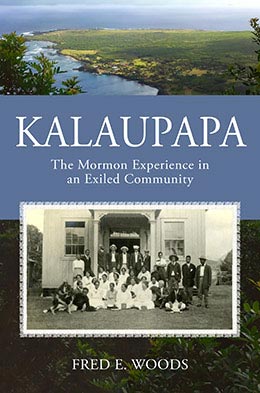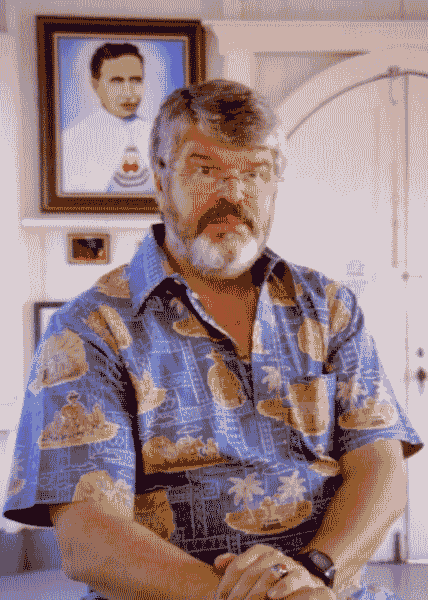Encounters Between Cultures
Captain Cook, Christian Ministers, and Mormon Missionaries come to Hawai'i
Fred E. Woods, "Encounters Between Cultures," in Kalaupapa: The Mormon Experience in an Exiled Community, Fred E. Woods (Religious Studies Center, Brigham Young University; Salt Lake City: Deseret Book, 2017), 1-18.
Before the story of the Kalaupapa community can be told, a brief history of the Hawaiian Islands and their people is in order. Commencing at least by the eighth century AD, Polynesians had settled what is now called Hawai‘i. Several hundred years later, migrants also came to the islands from Tahiti. Although Spanish vessels may have been aware of these Pacific islands when they sailed between Mexico and the Philippines, it was not until 1778 that Europeans officially recognized the Hawaiian Islands.[1]
Captain James Cook
Two years after America’s independence, British naval commander Captain James Cook led an adventurous expedition to locate a northwest passage around the American continent. He became the first European to make contact with the Polynesians on an archipelago he named the “Sandwich Islands” in honor of the fourth Earl of Sandwich (Sir John Montagu, 1718‒92), First Lord of the Admiralty. Tragically, Cook was killed by these island peoples in February 1779. News of his tragic death would not reach London until nearly a year later. Although many would mourn his passing, word soon spread of this Polynesian paradise later known as Hawai‘i.[2]
Although the beautiful oceanic oases were desirable, their remote location in the South Pacific made their settlement formidable. O. A. Bushnell wrote that the islands “are the most isolated of the world’s habitable places, and the most difficult to reach by sea. The Pacific hemisphere’s continents and the nearest of its high islands are more than 2,000 miles away. Between them and Hawai‘i lies the ocean-moat, broad, deep, and cruel. Of all the places that venturesome men have claimed as home, the islands of Hawai‘i probably were the last to be found.”[3] Yet, during the first half of the nineteenth century, as increasing numbers of seafaring foreign vessels plied the Pacific in search of whales, sandalwood, and other precious goods for trade, they more frequently contacted these islands. By the 1840s, whaling became Hawai‘i’s foremost trade industry. Such commerce significantly transformed Hawai‘i, altering the social, religious, political, and economic landscape of the Hawaiian people.[4]
 Nathaniel Dance, Captain James Cook (ca. 1775), National Maritime Museum, Greenwich. (Wikipedia Commons.)
Nathaniel Dance, Captain James Cook (ca. 1775), National Maritime Museum, Greenwich. (Wikipedia Commons.)
First Mormon Missionaries in the South Pacific
About this same time, Mormon missionaries entered the South Pacific in search of island converts. Addison Pratt, a young whaler who had jumped ship in Honolulu in the 1820s, later desired to return to the Sandwich Islands following his conversion to Mormonism. Having joined the Mormon faith in 1838, Pratt, his wife Louisa, and their four daughters migrated to Nauvoo, Illinois, in 1841. Nauvoo was then the designated Mormon gathering place.[5]
While living in Nauvoo, Pratt became acquainted with Joseph Smith, Brigham Young, and other Latter-day Saint Church leaders. This association eventually led to Pratt’s return to the Pacific. Pratt’s daughter Frances Pratt Dyer later explained, “One day in conversation with President Young in Nauvoo, they commenced to talk about those [Sandwich] islands and Brother Pratt expressed a strong desire to revisit them. Brother Brigham asked if he would be willing to be sent there on a mission. He said he would if he could have others sent with him. Accordingly, three others volunteered to go: B. F. Grouard, Noah Rogers, and Knowlton F. Hanks.”[6]
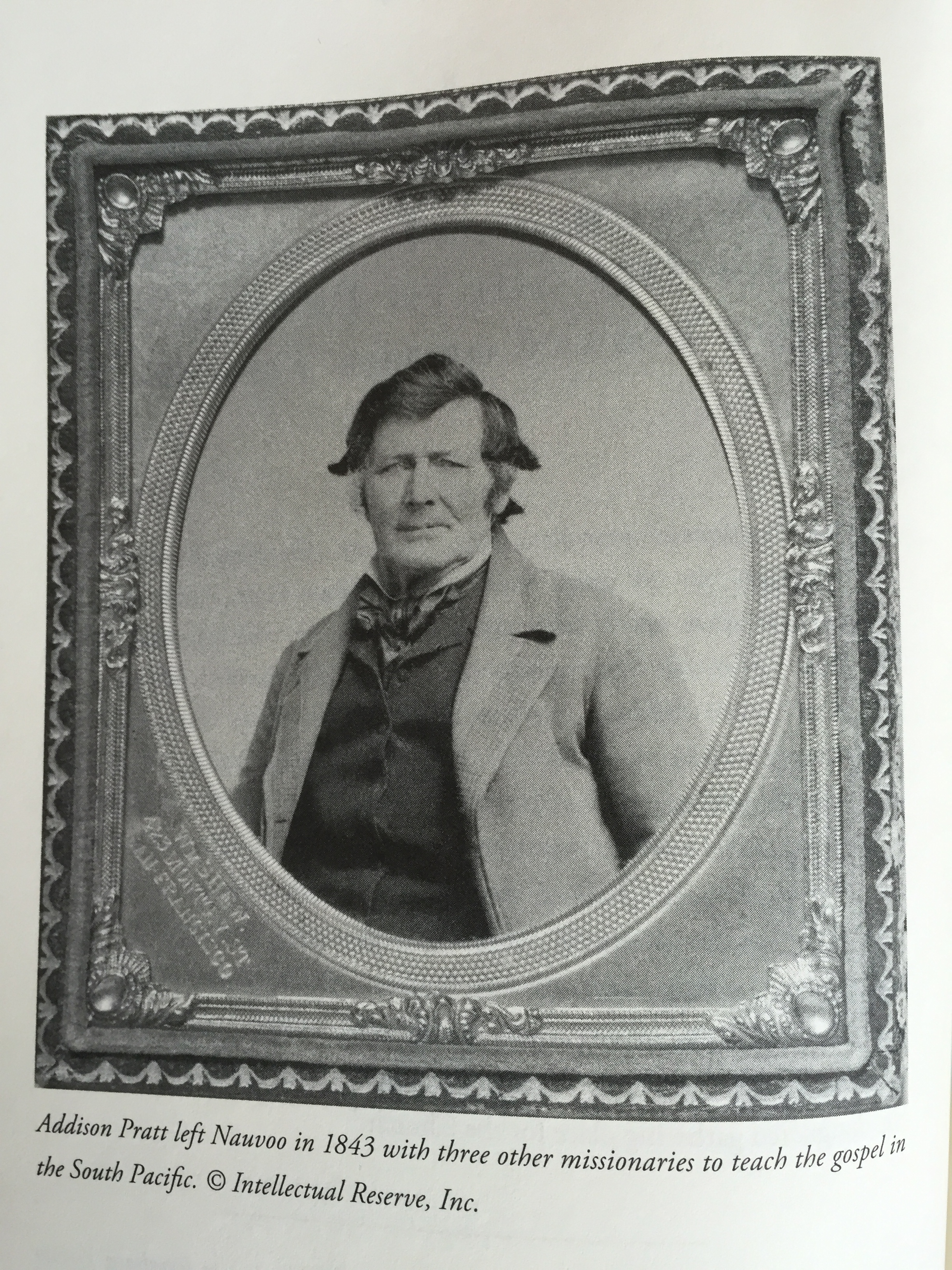 Addison Pratt, PH 1700 2810, Church History Library, Salt Lake City. (Courtesy of Intellectual Reserve, Inc.)
Addison Pratt, PH 1700 2810, Church History Library, Salt Lake City. (Courtesy of Intellectual Reserve, Inc.)
Charged to take the message of Mormonism to the Sandwich Islands, Pratt and his companions left Nauvoo in late spring of 1843, bound for New Bedford, Massachusetts, in search of passage to Honolulu. However, when Pratt tried to book passage for his missionary group, he learned that no vessels were sailing to Honolulu at that time. However, upon hearing that the whaling ship Timoleon was leaving for this region on October 9, 1843, the elders decided to redirect their proselytizing efforts to the Society Islands (French Polynesia).
Sadly, three weeks after embarking, Hanks died at sea. Rogers returned in 1845 to take care of his family after facing challenges from the British missionaries of the London Mission Society and after receiving news of trouble in Nauvoo. But Grouard found great success on the island of Anaa in the Tuamotus, and Pratt baptized many on the island of Tubuai. However, due to the strong hold which the French had on this Tahitian region, the first Mormon mission to the Pacific was halted in less than a decade.[7] Mormon missionaries did not return to the Pacific Islands until seven years later. This same year, 1850, was also the year that King Kamehameha III propelled a mission of his own by organizing a board of health to take measures against epidemic diseases to protect and cure his people.[8] So while the king was ministering to the physical needs of the islanders, the Mormons arrived at Honolulu to commence ministering to their spiritual needs.
Protestants and Catholics Enter Hawai‘i
Mormon proselytizing was successful in large part because of the pioneering efforts of prior missionaries of various denominations. The Protestants (Congregationalists) had been proselytizing the Sandwich Islands since 1820, the same year Mormon founder Joseph Smith proclaimed his vision of deity. These dedicated Protestant missionaries came from Boston, funded by the American Board of Commissioners for Foreign Missions (ABCFM).[9] These pious ministers had many groundbreaking accomplishments such as teaching literacy to the natives, translating the Bible into Hawaiian, and converting the natives from an ancient polytheistic tradition to a monotheistic Christian practice.[10]
Another ideal condition for introducing Christianity was the void left in Hawaiian cultural tradition by the abolition of kapu (laws of taboo), enacted in late 1819.[11] The people had relied on these centuries-old cultural restrictions, which dictated practices appropriate for royalty, but not for behavior pursuant to common males and females. The vacuum left by the discontinuance of these laws was eagerly replaced by the missionaries with the doctrines and practices of Christendom. The first Catholic missionaries in Hawai‘i coincided with Joseph Smith’s reception of the Book of Mormon in 1827. The Catholics met unyielding resistance from the Protestants until the French government interceded on their behalf.[12]
First Mormon Missionaries in Hawai‘i
With the Protestants and Catholics firmly rooted in Hawaiian missionary efforts, the instigation of Mormon missionaries sailing to the Sandwich Islands had its unlikely genesis in the gold fields of Northern California during the fall of 1850. Latter-day Saint Apostle Charles C. Rich visited a company of Mormons who had been sent from Utah the previous year on a “gold mission.” Church President Brigham Young strongly opposed the Saints running off to California in the pursuit of riches. Yet he was willing to make an exception, for it was agreed that the Mormon missionaries would bring whatever treasure they gleaned home to Utah. Elder Rich presided over this California region and had the authority of President Young to extend mission calls to the miners. One of the argonauts, Henry W. Bigler, recalled this practical counsel from Rich:
This morning the brethren was called together at the tent of Bro. Rich, he stated that he wanted some of us to go on a mission to the Sandwich Islands to preach the gospel, that his opinion was that it would cost no more to spend the winter there than it would here, that we could make nothing in the wintertime in consequence of so much water in the streams, and another thing provisions would be much higher in the mines and it would cost us more money to stay here and make nothing than if we went to the islands to preach.[13] Ten men accepted the call to go on what would be known as the Sandwich Islands Mission to bring spiritual strength to a people who had not yet heard the message of Mormonism. Embarking from San Francisco on November 15, 1850, they landed in Honolulu on December 12, 1850, after a successful voyage of just less than a month. The moment the anchor dropped, their vessel filled with Hawaiians clamoring to sell various kinds of fruits. One of the Mormon elders, twenty-three-year-old George Q. Cannon, recorded his thoughts on this curious occasion: “The monotonous character of their language, their rapid utterance, their numerous gestures, caused us to watch them with interest. We thought them a strange people. I little thought at that time that I would ever learn their language. . . . Though we had been sent on a mission to the Islands, we supposed our time would be occupied in preaching to the whites.”[14]
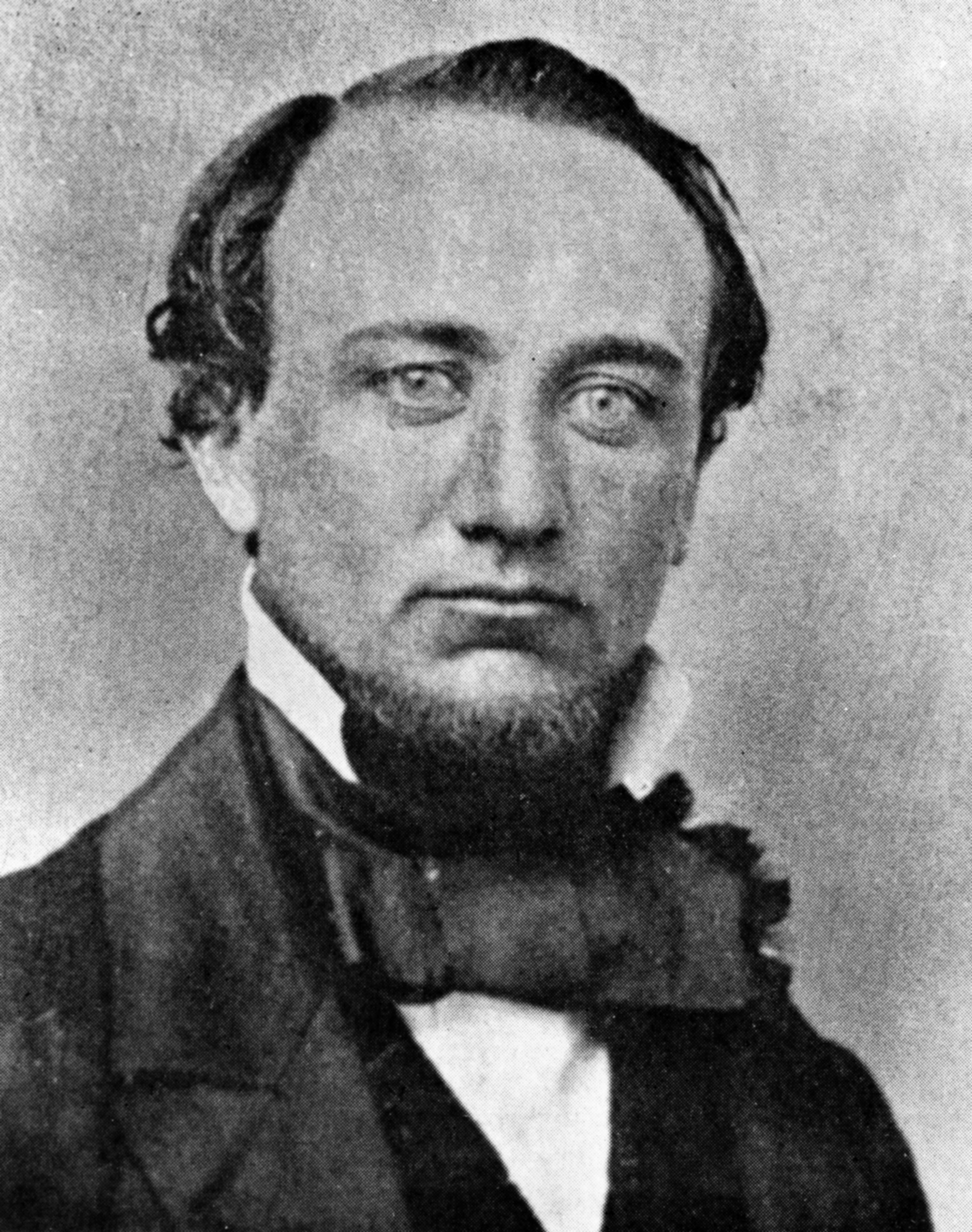 George Q. Cannon. (Courtesy of Intellectual Reserve, Inc.)
George Q. Cannon. (Courtesy of Intellectual Reserve, Inc.)
The following day, Cannon and his fellow companions ascended a high place near Honolulu and dedicated the land of Hawai‘i for the preaching of the gospel and forthwith commenced their labors.[15] One of the ten missionaries present on the occasion recorded the following:
We . . . went onto A mountain about three miles from the wharve [sic] and about 1,000 feet above the level of the sea: there on a small round knoll that rose several feet above the rest of the land around, and was about four or five rods across with a smooth flat surface: there each of us carried a stone and built an alter [sic]; we then sung a Hymn and each one then expressed his feelings and desires in regard to the mission we are now on. Bro Clark then offered up a prayer to the Lord that he would open the way that we might be enabled to preach the gospel on these Islands, and that we might have his spirit to be with us at all times to guide us in the way of truth and be preserved from the powers of the adversary and from every evil, and that the honest in heart might embrace the truth when they heard it, and that all who should appose [sic] the truth might be confounded.[16]
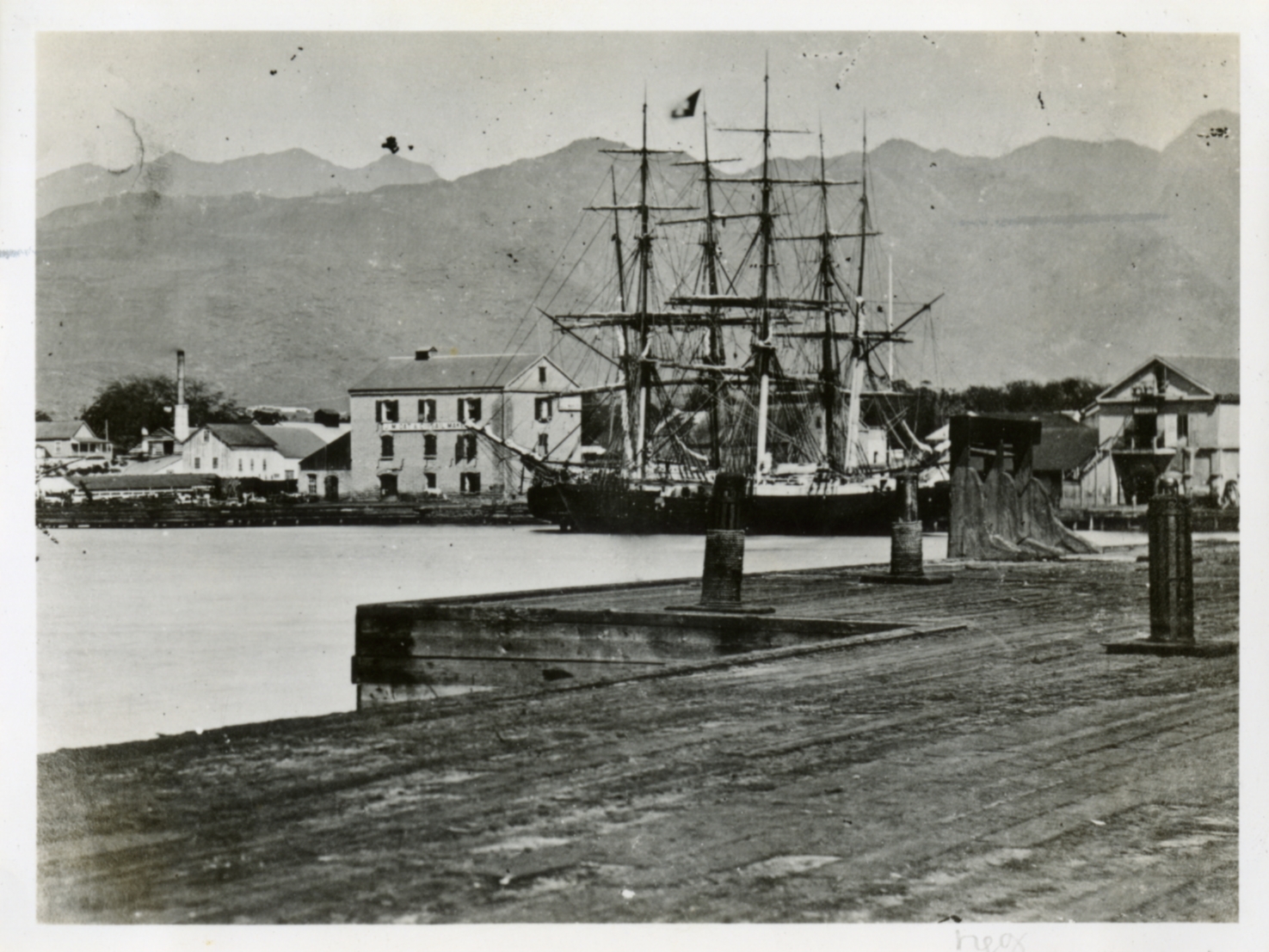 Honolulu Harbor, ca. 1850s. (Courtesy of Hawai‘i State Archives.)
Honolulu Harbor, ca. 1850s. (Courtesy of Hawai‘i State Archives.)
The missionaries met such stiff opposition throughout the first year that half of them returned home. The tide changed when Cannon met an influential Hawaiian judge on Maui named Jonathan H. Napela, who helped Cannon and his companions learn the native language and in the process became a valuable Latter-day Saint convert, assisting in the spread of Mormonism across the islands.[17] Less than three years from the time the Utah elders arrived in Honolulu, nearly three thousand native Hawaiians responded to an invitation to enter the waters of baptism.[18]
During the mid-nineteenth century, Mormon missionaries worldwide taught that following conversion, members should gather to the Utah Territory. However, Hawaiians were not permitted to travel to Utah at that time due to a law established by the kingdom of Hawai‘i which forbade emigration due to the dwindling native population.[19] Instead, Hawaiian Latter-day Saint converts were directed to assemble at a Hawaiian gathering place.[20]
Lāna‘i: First Hawaiian LDS Gathering Place (1854‒64)
By 1854, four thousand Hawaiians had joined the Latter-day Saint faith, and finding a gathering place for these new converts was well overdue. Writing to Cannon, Brigham Young counseled, “I will suggest that if possible you obtain a fitting Island or portion of an island where the brethren can collect in peace and sustain themselves unmolested, it might be much pleasanter for them, and they be better able to prepare themselves for gathering to this continent when the way shall open.”[21]
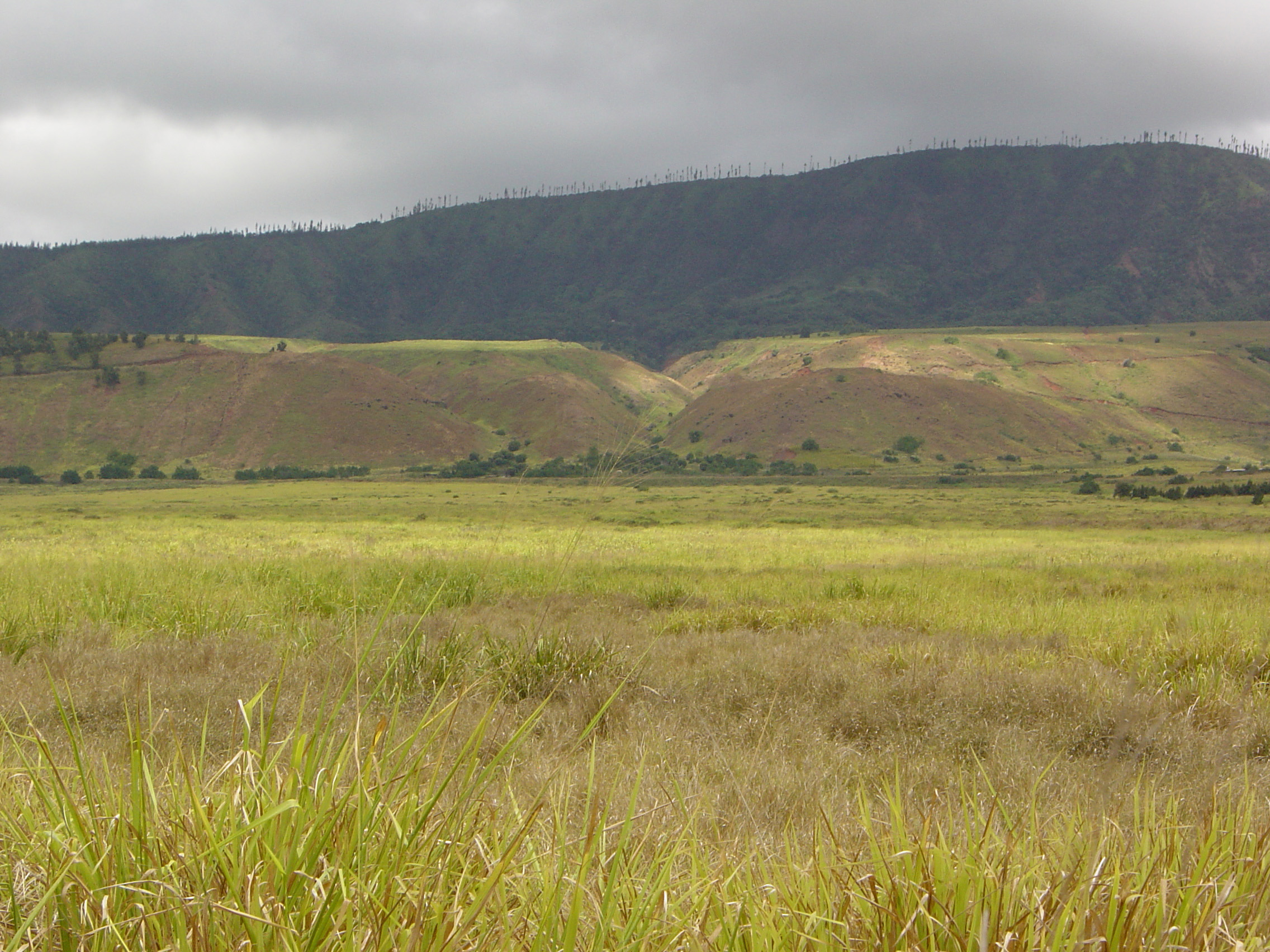 Pālāwai Basin on Lāna‘i where Mormons gathered 1854–64. (Courtesy of Jace McQuivey.)
Pālāwai Basin on Lāna‘i where Mormons gathered 1854–64. (Courtesy of Jace McQuivey.)
After searching for such a location, Francis Hammond described a beautiful spot on the Hawaiian island of Lāna‘i: “Lying at the foot of the large mountain on the east and extending toward a high ridge on the west, which enclosed completely a large tract of good land, perhaps 5,000 acres of which was in full view. . . . I have never seen a better tract of land in one body on these islands. I can see only one drawback to the place and this is the scarcity of water during the dry season.”[22]
Describing this beautiful Pālāwai Basin, Cannon wrote, “It reminded me of Deseret. It was a splendid piece of land and seemed to be well adapted for a gathering place so far as quality of soil and situation is concerned. . . . [Yet] we found no running water, . . . and the prospect of supplying the wants of the community from such a source was poor indeed.”[23]
Thus, Lāna‘i, though beautiful, was parched and served only for a time as a gathering place for the island converts.[24] Mormon missionaries serving in Hawai‘i were called home in 1858, largely because of a conflict between the United States government and the Church of Jesus Christ of Latter-day Saints in what later became known as the Utah War. Several years later, a Mormon by the name of Walter Murray Gibson arrived on Lāna‘i, and, on announcing his self-appointment as president of the LDS Church on the islands, took advantage of the island converts during the years 1861 to 1864. Upon hearing of his deception via letters sent to Salt Lake City by some of the Hawaiians on Lāna‘i, Church leadership soon dispatched Utah missionaries to challenge the discrepancies of the rogue leader; consequently, Gibson was excommunicated for his poor behavior.[25]
New Mormon Gathering Place in Lā‘ie
In the meantime, Joseph F. Smith, acting as mission president of the Sandwich Islands, suggested to Brigham Young that there be a new gathering place for the Hawaiians. In October 1864, Brigham Young sent Francis A. Hammond and George Nebeker to find a new gathering place. The emissaries visited Joseph F. Smith and William Cluff in San Francisco on their way back to Utah.[26] Hammond later learned that Thomas T. Dougherty of Honolulu was interested in selling property in Lā‘ie. On January 26, 1865, Hammond purchased 6,500 acres (the ahupua‘a of Lā‘ie) from Dougherty for $14,000. Hammond wrote, “It contains some 6000 acres, about 1000 of which is arable land. . . . We took possession on the 28th of last January, by agreeing to pay $5000 in ten weeks: $3000 by the 1st of July, and $6000 in two years.”[27]
Thus, in January of 1865, Lā‘ie became the official gathering place for the Hawaiian Saints and remained so for over a century.[28] But during the nineteenth and twentieth centuries, Latter-day Saints who contracted leprosy, later known as Hansen’s disease,[29] were not allowed to join their fellow church members in Lā‘ie. An alternative settlement was prepared for them by the Hawaiian monarchy, though it was not their preferred choice. This island peninsula was reserved for exiles, irrespective of religiosity or ethnicity, who shared this common dreaded malady.
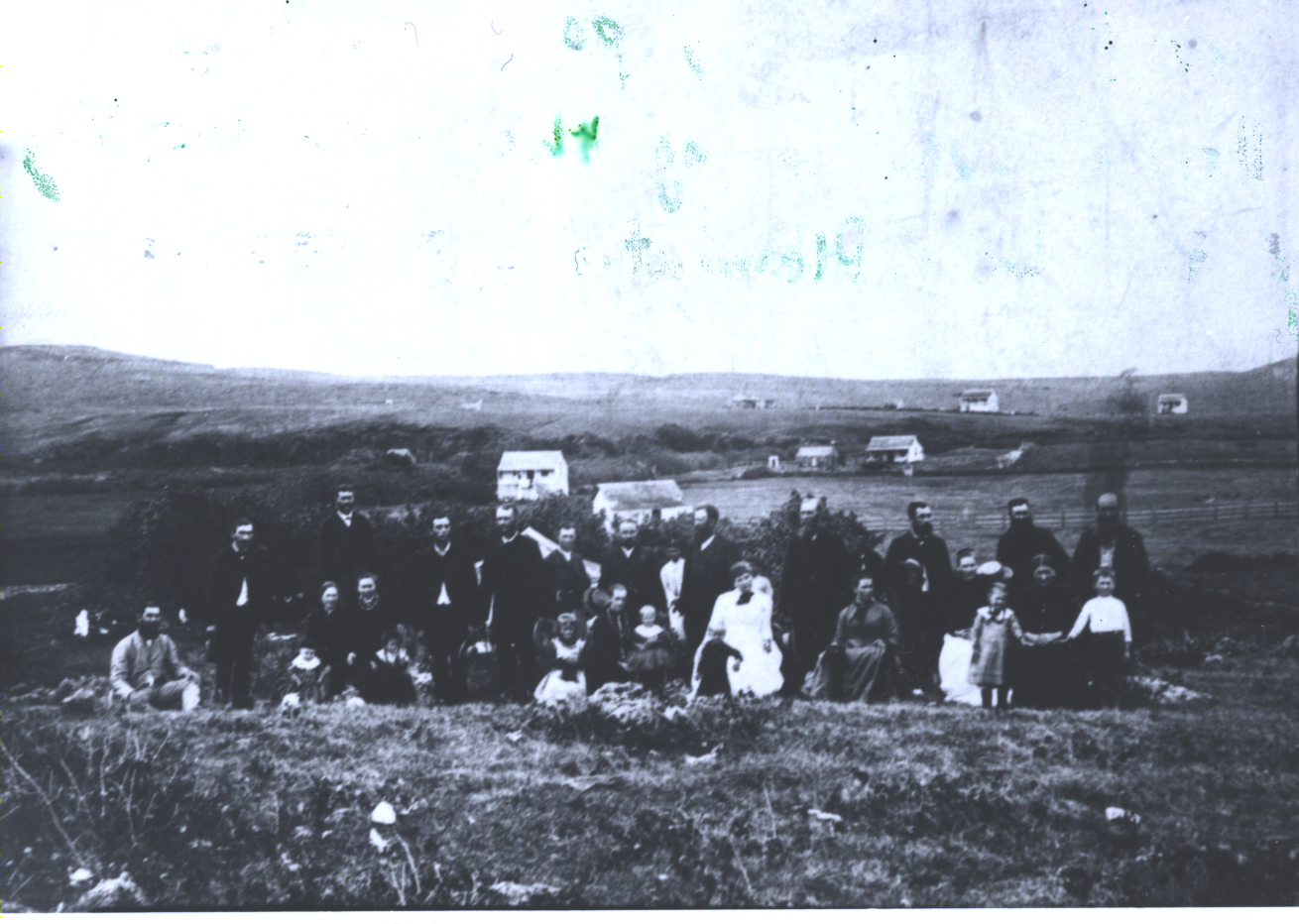 Utah missionaries at Lā‘ie the LDS gathering place. (Courtesy of Intellectual Reserve, Inc.)
Utah missionaries at Lā‘ie the LDS gathering place. (Courtesy of Intellectual Reserve, Inc.)
Notes
[1] Linda W. Greene, Exile in Paradise: The Isolation of Hawai‘i’s Leprosy Victims and Development of Kalaupapa Settlement, 1865 to the Present (Denver: National Park Service, Denver Service Center, 1985), 1. For a current version of migration issues, see Patrick V. Kirch, A Shark Going Inland Is My Chief: The Island Civilization of Ancient Hawai‘i (Berkeley: University of California Press, 2012).
[2] Vanessa Collingridge, Captain Cook: The Life, Death and Legacy of History’s Greatest Explorer (London: Ebury Press, 2003), 327, 380, 411–15, 421–23. See also http://
[3] O. A. Bushnell, The Gifts of Civilization: Germs and Genocide in Hawai‘i (Honolulu: University of Hawai‘i Press, 1993), 1.
[4] Matthew Kester, Remembering Iosepa: History, Place, and Religion in the American West (New York: Oxford University Press, 2013), 12.
[5] S. George Ellsworth, ed., The Journals of Addison Pratt (Salt Lake City: University of Utah Press, 1990), 1–18.
[6] Eugene M. Cannon, “Tahiti and the Society Island Mission,” Juvenile Instructor 32, no. 11 (June 1897): 334. Young’s request for Pratt to serve a mission to the islands of the sea was certainly in concert with Joseph Smith’s vision of Latter-day Saint missionary work. Smith advocated, “Don’t let a single corner of the earth go without a mission.” Teachings of Presidents of the Church: Joseph Smith (Salt Lake City: The Church of Jesus Christ of Latter-day Saints, 2007), 155. See also Scott G. Kenney, ed., Wilford Woodruff Journals, 9 vols. (Midvale, UT: Signature Books, 1983), 2:233. This specific volume, for the date of May 23, 1843, notes, “We set apart Elders Noah Rogers, Addison Pratt, Benjamin F. Grouard & Knowlton Hanks to take a mission to the Sandwich Islands.”
[7] For the full story, see Fred E. Woods, “Launching Mormonism in the South Pacific: The Voyage of the Timoleon,” in Go Ye into All the World: The Growth and Development of Mormon Missionary Work, ed. Reid L. Neilson and Fred E. Woods (Provo, UT: Religious Studies Center; Salt Lake City: Deseret Book, 2012), 191–216.
[8] Greene, Exile in Paradise, xxiv.
[9] Greene, Exile in Paradise, 2–3 reads, “On June 27, 1810, in Bradford, Massachusetts, an American Board of Commissioners for Foreign Missions [ABCFM] was instituted, whose object was ‘to devise, adopt, and prosecute ways and means for propagating the gospel among those who are destitute of the Knowledge of Christianity.’ Its members belonged to the Congregational and Presbyterian churches. When American Protestant missionaries came to Hawaii in 1820, they encountered the old Hawaiian religion. . . . The kapu or taboo system was an extremely important part of this religion and prescribed numerous prohibitions, such as forbidding men and women from eating together. . . . Two of Kamehameha the Great’s widows, however, were instrumental in overthrowing the kapu system. These two women persuaded Liholiho to abolish the old kapu and the old religion. Throughout the islands the images of the old gods were destroyed, heiau [high places] demolished, and the people forbidden by royal decree to worship the old gods. Hawai‘i thus became a fertile field for American evangelism and the planting of new religions.”
[10] R. Lanier Britsch, Moramona: The Mormons in Hawaii (Lā‘ie, HI: Institute for Polynesian Studies, 1989), 10‒12.
[11] For more information on the abolition of the kapu system, see Ralph S. Kuykendall, The Hawaiian Kingdom, vol. 1, 1778–1854, Foundation and Transformation (Honolulu: University of Hawai‘i Press, 1938), 65–70.
[12] For the history of early Catholic missiology in the Hawaiian Islands, see Father Reginald Yzendoorn, SS.CC., History of the Catholic Mission in the Hawaiian Islands (Honolulu: Honolulu Star-Bulletin, 1927), and Robert Schoofs, Pioneers of the Faith: History of the Catholic Mission in Hawaii, 1827–1940 (WaiKāne, HI: Louis Boeynaems, 1978).
[13] Diary of Henry Bigler, Book B, September 25, 1850, Church History Library, Salt Lake City. According to Andrew Jenson, Latter-day Saint Biographical Encyclopedia (Salt Lake City: Andrew Jenson History Company, 1914), 3:599, Bigler was born in 1815 in West Virginia. Having embraced Mormonism in his youth, he later served in the Mormon Battalion. He is known to be the first person to record the discovery of gold (January 24, 1848), which he did while working for James Marshall. Bigler served a mission to the Hawaiian Islands from 1850 to 1854 and returned to serve from 1857 to 1858. He later settled in St. George, Utah, where he died on November 24, 1900. For an overview of the Mormon mining mission, see Eugene Campbell, “The Mormon Gold Mining Mission of 1849,” BYU Studies 1, no. 2, and 2, no. 1 (Autumn 1859–Winter 1860): 19‒31. See also Leonard J. Arrington, Great Basin Kingdom: An Economic History of the Latter-day Saints 1830–1900 (Lincoln, NE: University of Nebraska Press, 1958): 72–76. For an excellent treatment of the life of Charles C. Rich, see Leonard J. Arrington, Charles C. Rich, Mormon General and Western Frontiersman (Provo, UT: Brigham Young University Press, 1974).
[14] Andrew Jenson, “Manuscript History of the Hawaiian Mission of the Church of Jesus Christ of Latter-day Saints,” 5 vols. (Salt Lake City: The Church of Jesus Christ of Latter-day Saints, 1935), typescript, December 12, 1850. This typescript lacks pagination and is hereafter cited as MHHM. Cannon later recorded having the strong impression that he should preach to the Hawaiian natives. He learned the language very quickly and, of the original ten who embarked on this mission, he found the most success by way of numbers of converts. Cannon told the story of his mission to the Hawaiian Islands (1850–54) in My First Mission: Designed for the Instruction and Encouragement of Young Latter-day Saints (Salt Lake City: Juvenile Instructor Office, 1882).
[15] MHHM, December 13, 1850. The area where the missionaries offered a prayer is now known as Pacific Heights.
[16] William Farrer, Biographical Sketch, Hawaiian Mission Report and Diary of William Farrer, 1821–1906, December 13, 1850, typescript, 45, L. Tom Perry Special Collections, Harold B. Lee Library, Brigham Young University, Provo, UT. Concerning this sacred occasion, Cannon noted in his own journal, “We crossed the stream here and ascended the mountain to the right of the Valley. When we got near to where we wanted to stop we picked up a stone apiece and carried up with us; we ascended a knob that rose up precipitously on all sides and formed a table of about thirty or thirty-five feet wide; we then made an altar of our stones <and sung a hymn> and then all spoke round what our desires were; & selected Bro. Clark to be mouth. We had the spirit with us. I could feel it very sensibly. Our desires principally <were> that the Lord would make a speedy work here on these Islands and that an effectual door might be opened for the preaching of the gospel and that all opposers might be confounded and that our lives might be spared to get home again.” Journals of George Q. Cannon, December 13, 1850, Church History Library, The Church of Jesus Christ of Latter-day Saints, Salt Lake City.
[17] For information on Napela, see Fred E. Woods, “A Most Influential Mormon Islander: Jonathan Hawai‘i Napela,” Hawaiian Journal of History 42 (2008): 135–57; Fred E. Woods, “An Islander’s View of a Desert Kingdom: Jonathan Napela Recounts His 1869 Visit to Salt Lake City,” BYU Studies 45, no. 1 (2006): 23–34; and Fred E. Woods, “Jonathan Napela: A Noble Hawaiian Convert,” in Regional Studies in Church History for the South Pacific, ed. Reid L. Neilson, Steven C. Harper, Craig K. Manscill, and Mary Jane Woodger (Provo, UT: Religious Studies Center, 2008), 23–36.
[18] MHHM, October 6, 1853, provides statistics from the October 1853 mission conference for the Sandwich Islands which reveal that by this time there were “53 branches with a total membership of 2986 members, [including] 29 Elders, 72 Priests, 126 Teachers and 144 Deacons.” Ralph S. Kuykendall, The Hawaiian Kingdom, vol. 1, 1778–1854: Foundation and Transformation (Honolulu: University of Hawai‘i Press, 1938), 344, notes that the way the Mormons proselytized was different from that of the Catholics and Protestants; they “began to appoint native converts to various offices of the church, thus placing upon them a measure of responsibility.” This no doubt aided in the rapid success of the Latter-day Saints’ work in the islands. Yet about this same time, a serious smallpox epidemic swept the Hawaiian Islands and a number of LDS converts died. Elder Benjamin F. Johnson was heartbroken to see these new proselytes suffering. Trying to make sense of the matter he pondered why the Lord would cause them to be taken. He wrote, “I pondered the subject prayerfully until the light of the Lord shone upon my understanding, and I saw multitudes of their race in the spirit world who had lived before them, and there was not one there with the priesthood to teach them the gospel. The voice of the Spirit said to me, ‘Sorrow not, for they are now doing that greater work for which they were ordained, and it is all of the Lord.’” See Benjamin F. Johnson, My Life’s Review (Independence, MO: Zion’s Printing and Publishing, 1947), 157.
[19] The Penal Code of the Hawaiian Islands Passed by the House of Nobles and Representatives on the 21st of June, A.D. 1850 . . . (Honolulu: Henry M. Whitney, 1850), 154–55, contains a document titled “An Act to Prohibit Natives from Leaving the Island.” This record explains that due to a serious decrease in population on the Hawaiian Islands, commencing in 1850, no native was allowed to “emigrate to California, or other foreign country, unless for some urgent necessity,” and in those cases, there would still need to be permission granted by the governor via a passport. To view the entire content of this act, see appendix A, “An Act to Prohibit Natives from Leaving the Islands.” Please note that this law was repealed by the 1859 Legislature. See the 1859 Civil Code of the Hawaiian Islands, chapter 40, section 1491, 364, Hawai‘i State Archives. Thanks to Jason Achiu, archivist for the Hawai‘i State Archives, for his assistance with these documents.
[20] Fred E. Woods, “The Palawai Pioneers on the Island of Lanai: The First Hawaiian Latter-day Saint Gathering Place (1854–1864),” Mormon Historical Studies 5, no. 2 (Fall 2004): 3.
[21] Brigham Young to George Q. Cannon dated June 15, 1853, Church History Library, The Church of Jesus Christ of Latter-day Saints, Salt Lake City, UT.
[22] Francis A. Hammond, Journal, September 28, 1853, Church History Library.
[23] George Q. Cannon Journal, 19 October 1853, Church History Library.
[24] For a detailed history of the Lāna’i gathering experience, see Fred E. Woods, “The Palawai Pioneers on the Island of Lanai: The First Hawaiian Latter-day Saint Gathering Place (1854–1864),” Mormon Historical Studies 5, no. 2 (Fall 2004): 3–35; and Raymond Beck, “Palawai Basin: Hawaii’s Mormon Zion” (master’s thesis, University of Hawaii, 1972).
[25] Woods, “The Palawai Pioneers on the Island of Lanai,” 24–25. For detailed treatments of Water Murray Gibson and his deception at Lāna’i, see Gwynn Barrett, “Walter Murray Gibson: The Shepherd Saint of Lanai Revisited,” Utah Historical Quarterly 40, no. 2 (1972): 142–62; R. Lanier Britsch, “Another Visit with Walter Murray Gibson,” Utah Historical Quarterly 46, no. 1 (1978): 65–78.
[26] R. Lanier Britsch, Moramona: The Mormons in Hawaii (Lā‘ie, HI: The Institute for Polynesian Studies, BYU–Hawaii, 1989), 63.
[27] The sales price of the Lā‘ie property of $14,000 is noted in the Journal of Francis A. Hammond, January 26, 1865, MS 1430, Church History Library. See also Francis A. Hammond letter to President Daniel Wells, May 7, 1865, Millennial Star 33, no. 28 (August 19, 1865), 527. Further, a telegraph dated February 21, 1865, from Francis A. Hammond to Brigham Young reported, “Six thousand five hundred 6500 acres fourteen thousand 14000 dollars entire cost bought of L. L. Dougherty land with improvements six hundred 600 head of cattle. Five hundred 500 sheep twenty 20 horses two hundred and fifty 250 native houses furnished all inside of a stone enclosure of four 4 acres. Five 5 acres of cotton doing well situated on the weather side of Oahu names of Land Lā‘ie—Seventy 70 Natives belonging to the church now living on the land five thousand 5000 dollars to be paid in ten 10 weeks from the eighteenth 18 of January three thousand 3000 by July six thousand 6000 in two 2 years—I wish you to make the purchase if I fail to make the first payment I forfeit all the labour that will be put on the land. I expect to have one hundred 100 acres of cotton in by the first of March Smith and Cluff have charge of it until I return. Mr. Linsforth has offered to loan the money, it is a good thing will you pay my fare from Virginia City. F. A. Hammond.” Two months later, Brigham Young wrote to Kamehameha V explaining that the Mormon settlement in Lā‘ie would have religious teachers, “but will not confine their labors to spiritual matters only.” For the full content of this document, see appendix C, “Letter of Brigham Young to Kamehameha V” (March 24, 1865). The king’s response, through his secretary, was, “His Majesty would view as a great misfortune, the permanent introduction as a Body of Religious Teachers of men who look to a foreign head, for political as well as religious teaching—whose presence in other and stronger states where the people are more advanced and opinion free has been productive of discord and been wars.” However, the Mormons were still allowed to dwell in the Hawaiian Islands, notwithstanding the apparent apprehension stemming from the Utah War. For a full treatment of the king’s response via his secretary John Dominis, see appendix D, “Letter of John Dominis to Brigham Young on behalf of King Kamehameha V, 1865.”
[28] For a full treatment on the history of gathering to Lā‘ie, see Riley M. Moffat, Fred E. Woods, and Jeffrey N. Walker, Gathering to Lā‘ie (Lā‘ie, HI: The Jonathan Napela Center for Hawaiian and Pacific Islands Studies, BYU–Hawaii), 2011.
[29] Dr. Gerhard Henrik Armauer Hansen, a Norwegian physician, detected the leprosy bacillus (mycobacterium leprae) in 1873. The alternative modern term now used in the medical field for this sickness is Hansen’s disease. The author has tried to be sensitive in using the terms leper or leprosy as these terms are currently objectionable. However, they are maintained in historical documents when they are part of a direct quote. Dr. Kalani Brady said: “Hansen’s disease is not a bacterium that is easily transmitted. It’s not like a cold virus. You have to be susceptible to it, and only about 5 percent of the population, of all humans, are susceptible. Some are more susceptible than others. Polynesians, Micronesians, Southeast Asians, and South Asians are more susceptible. Some, like Damien, was one of only two health care workers in the 150-year history of the settlement who were susceptible and caught the disease. So you can, with antibiotics, take care of a Hansen’s patient with active Hansen’s disease; and it’s very unlikely you will catch it. Moreover, it’s spread, we think, through the droplet nuclei of the cough. That’s probably the only way it’s spread, although not all the experts agree.” Dr. Kalani Brady, interview by Ethan Vincent, assisted by Fred E. Woods, June 25, 2007, Kalaupapa.
